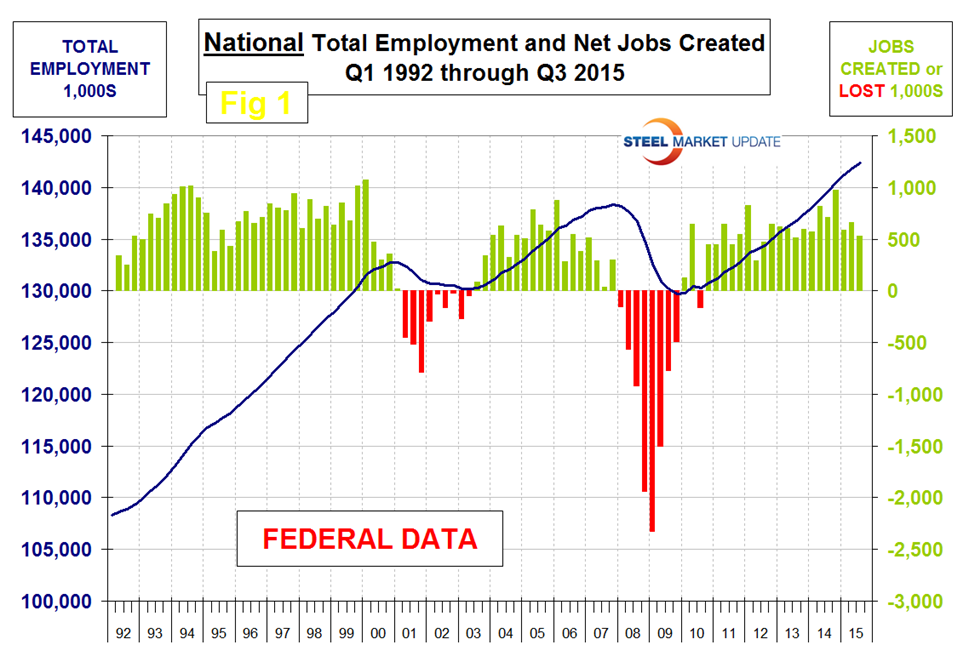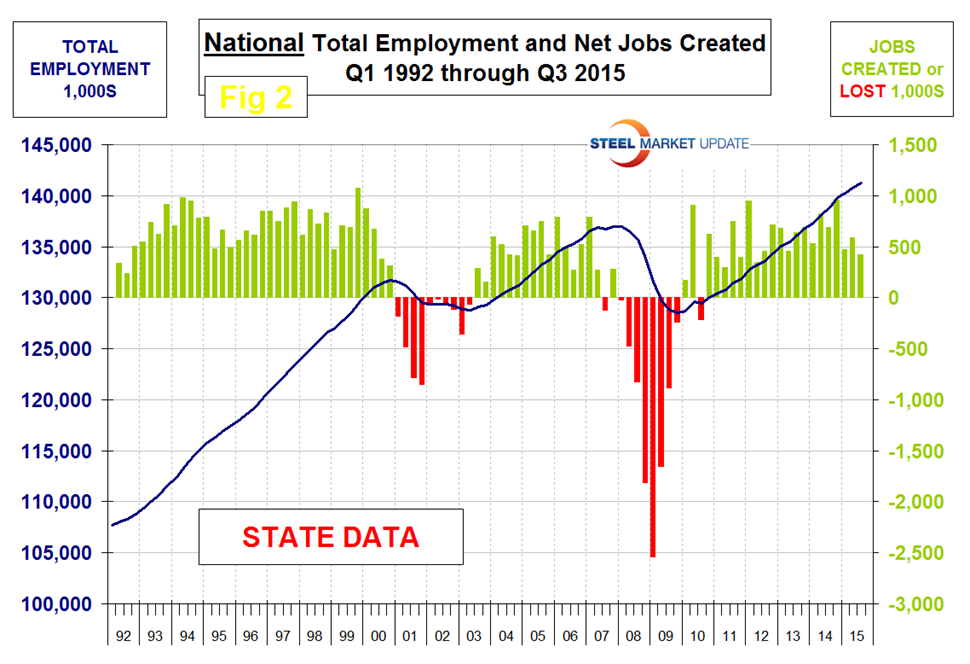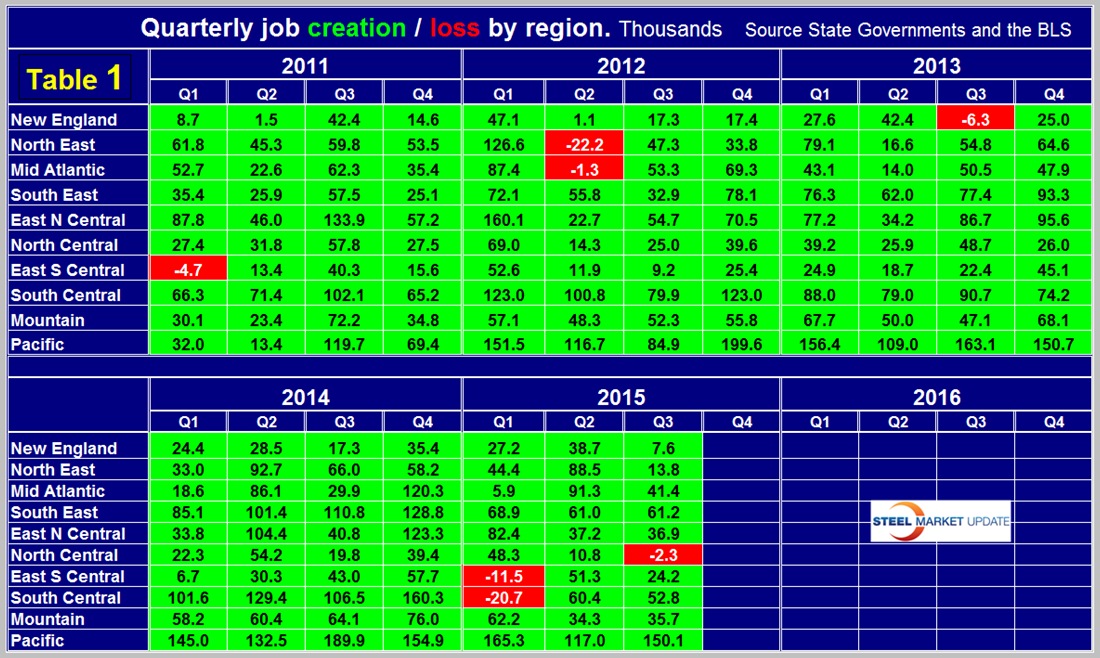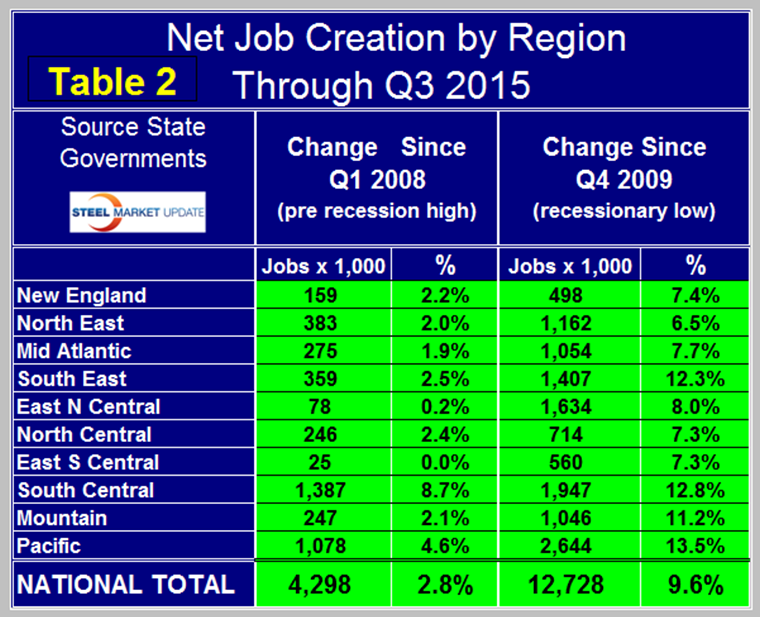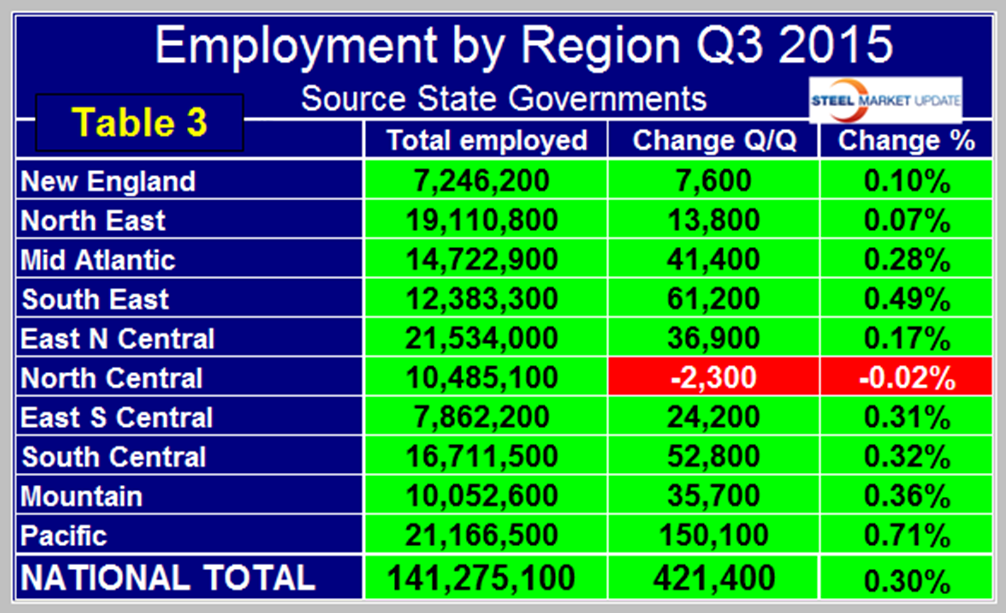Economy

Regional Job Creation through Q3 2015
Written by Peter Wright
October 26, 2015
The states compile their employment numbers independently of the Feds then both are reported by the Bureau of Labor Statistics. The results are very close. In the last six quarters since Q1 2014, the Feds reported total job creation of 4,849,000 and the states reported 4,475,000. Figure 1 and Figure 2 show the history of Federal and State totals since 1992.
SMU has graphs in the same format for 10 geographic regions and can produce for individual states if a reader so requests.
Table 1 shows the history of quarterly job creation by region for the last 4 ¾ years.
All regions except the North Central (IA, KS, MN, MO, NE, ND and SD) had positive job creation in the third quarter. Within the NC region, Iowa and Nebraska had positive growth of 3,700 and 3,800 jobs respectively but North Dakota lost 4,400 jobs as horizontal drilling activity slowed. The South Central region went off a cliff in Q1 this year after having the highest job creation of any region in the previous quarter. This region rebounded in Q2 and Q3 but is nowhere near where it was before the oil price collapse. From an energy point of view, Texas has recovered somewhat due to its diversified economy but North Dakota has not. In every quarter of 2015, the Pacific region (CA, OR and WA) has created the most jobs.
The Associated General Contractors of America reported on construction employment through September and reported as follows: “Construction employment expanded in 35 states and the District of Columbia between September 2014 and September 2015 yet only 23 states added jobs between August and September. Association officials said the fact as many states lost construction jobs as added them last month was likely due to a combination of labor shortages and uncertainty about a host of federal investment programs. Depending on the kind of work they perform, many contractors either can’t find enough workers, or they can’t find enough work. While overall demand for construction continues to grow and sap the pool of available labor, firms that work on federally-funded projects are dealing with a lot of uncertainty. California added the most new construction jobs (43,900 jobs, 6.4 percent) between September 2014 and September 2015. Other states adding a high number of new construction jobs for the past 12 months include Florida (26,700 jobs, 6.6 percent), Washington (11,400 jobs, 7.1 percent) and Pennsylvania (11,300 jobs, 4.9 percent). Arkansas (16.1 percent, 7,400 jobs) added the highest percentage of new construction jobs during the past year, followed by Alaska (11.2 percent, 1,900 jobs), Kansas (9.5 percent, 5,600 jobs) and South Carolina (9.0 percent, 7,400 jobs). Fourteen states shed construction jobs during the past 12 months, while construction employment was unchanged in Oregon. West Virginia (-16.9 percent, -5,800 jobs) lost the highest percent of construction jobs. Other states that lost a high percentage of jobs for the year include Rhode Island (-10.9 percent, -1,800 jobs), Ohio (-6.3 percent, -12,400 jobs) and Mississippi (-5.1 percent, -2,400 jobs). The largest job losses occurred in Ohio, West Virginia, Minnesota (-2,700 jobs, -2.5 percent) and Mississippi.”
The regions have fared very differently since the pre-recession high of Q1 2008 and since the low point of Q4 2009. There are now 4,298,000 more people employed than there were immediately before the recession but of that number over half occurred in the South Central (TX, LA, AR and OK) and Pacific regions. For the first time this quarter, every region has more people employed than it did at the pre-recession peak. The East South Central (AL, KEN, MIS, and TEN) just made it over the line with a 0.01 percent improvement (Table 2).
Employment is now 12,728,000 positions higher than it was at the low point of the recession. The Pacific has had the largest number of jobs created during the recovery with an increase of 2,644,000 positions which amounts to 13.5 percent of total employment. The South Central is in second place with 1,974,000 jobs created which is 12.8 percent of total employment. The East North Central (IL, IN, MI, OH and WI) currently has the highest number of employed people with 21,534,000, closely followed by the Pacific with 21,166,500 (Table 3).

Peter Wright
Read more from Peter WrightLatest in Economy

Chicago Business Barometer falls back in April, remains in contraction
The Chicago Business Barometer declined in April, reversing March’s gains, according to Market News International (MNI) and the Institute for Supply Management (ISM).

Fewer manufacturers optimistic about the economy
PMA’s April report shows that only 16% of surveyed manufacturers anticipate an increase in economic activity in the next three months (down from 23% in March)

Architecture billings continue to slide in March
Architecture firms said billings continued to decline in March, according to the latest Architecture Billings Index (ABI) released by the American Institute of Architects (AIA) and Deltek.

Beige Book shows concerns about trade policy
Manufacturing was mixed, but two-thirds of districts said activity was little changed or had declined.

New York state manufacturing index drops again in April
Firms were pessimistic, with the future general business conditions index falling to its second lowest reading in the more than 20-year history of the survey

